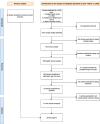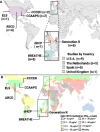This is a preprint.
A Systematic Review of Air Pollution Exposure and Brain Structure and Function during Development
- PMID: 39314970
- PMCID: PMC11419233
- DOI: 10.1101/2024.09.13.24313629
A Systematic Review of Air Pollution Exposure and Brain Structure and Function during Development
Update in
-
A systematic review of air pollution exposure and brain structure and function during development.Environ Res. 2025 Jun 15;275:121368. doi: 10.1016/j.envres.2025.121368. Epub 2025 Mar 10. Environ Res. 2025. PMID: 40073924
Abstract
Objectives: Air pollutants are known neurotoxicants. In this updated systematic review, we evaluate new evidence since our 2019 systematic review on the effect of outdoor air pollution exposure on childhood and adolescent brain structure and function as measured by magnetic resonance imaging (MRI).
Methods: Using PubMed and Web of Science, we conducted an updated literature search and systematic review of articles published through March 2024, using key terms for air pollution and functional and/or structural MRI. Two raters independently screened all articles using Covidence and implemented the risk of bias instrument for systematic reviews informing the World Health Organization Global Air Quality Guidelines.
Results: We identified 222 relevant papers, and 14 new studies met our inclusion criteria. Including six studies from our 2019 review, the 20 publications to date include study populations from the United States, Netherlands, Spain, and United Kingdom. Studies investigated exposure periods spanning pregnancy through early adolescence, and estimated air pollutant exposure levels via personal monitoring, geospatial residential estimates, or school courtyard monitors. Brain MRI occurred when children were on average 6-14.7 years old; however, one study assessed newborns. Several MRI modalities were leveraged, including structural morphology, diffusion tensor imaging, restriction spectrum imaging, arterial spin labeling, magnetic resonance spectroscopy, as well as resting-state and task-based functional MRI. Air pollutants were associated with widespread brain differences, although the magnitude and direction of findings are largely inconsistent, making it difficult to draw strong conclusions.
Conclusion: Prenatal and childhood exposure to outdoor air pollution is associated with structural and functional brain variations. Compared to our initial 2019 review, publications doubled-an increase that testifies to the importance of this public health issue. Further research is needed to clarify the effects of developmental timing, along with the downstream implications of outdoor air pollution exposure on children's cognitive and mental health.
Keywords: air pollution; magnetic resonance imaging; neurodevelopment; neurotoxicity; particulate matter.
Conflict of interest statement
Competing Interests The authors declare no competing interests.
Figures






Similar articles
-
A systematic review of air pollution exposure and brain structure and function during development.Environ Res. 2025 Jun 15;275:121368. doi: 10.1016/j.envres.2025.121368. Epub 2025 Mar 10. Environ Res. 2025. PMID: 40073924
-
Associations of Air Pollution on the Brain in Children: A Brain Imaging Study.Res Rep Health Eff Inst. 2022 Feb;2022(209):1-61. Res Rep Health Eff Inst. 2022. PMID: 36106707 Free PMC article.
-
Outdoor Air Pollution and Brain Structure and Function From Across Childhood to Young Adulthood: A Methodological Review of Brain MRI Studies.Front Public Health. 2019 Dec 6;7:332. doi: 10.3389/fpubh.2019.00332. eCollection 2019. Front Public Health. 2019. PMID: 31867298 Free PMC article.
-
Mortality and Morbidity Effects of Long-Term Exposure to Low-Level PM2.5, BC, NO2, and O3: An Analysis of European Cohorts in the ELAPSE Project.Res Rep Health Eff Inst. 2021 Sep;2021(208):1-127. Res Rep Health Eff Inst. 2021. PMID: 36106702 Free PMC article.
-
Indoor and outdoor air pollution and couple fecundability: a systematic review.Hum Reprod Update. 2023 Jan 5;29(1):45-70. doi: 10.1093/humupd/dmac029. Hum Reprod Update. 2023. PMID: 35894871 Free PMC article.
References
-
- Alemany S., Vilor-Tejedor N., García-Esteban R., Bustamante M., Dadvand P., Esnaola M., Mortamais M., Forns J., van Drooge B.L., Álvarez-Pedrerol M., Grimalt J.O., Rivas I., Querol X., Pujol J., Sunyer J., 2018. Traffic-Related Air Pollution, APOEε4 Status, and Neurodevelopmental Outcomes among School Children Enrolled in the BREATHE Project (Catalonia, Spain). Environ Health Perspect 126, 087001. 10.1289/EHP2246 - DOI - PMC - PubMed
-
- Alex A.M., Buss C., Davis E.P., Campos G. de los, Donald K.A., Fair D.A., Gaab N., Gao W., Gilmore J.H., Girault J.B., Grewen K., Groenewold N.A., Hankin B.L., Ipser J., Kapoor S., Kim P., Lin W., Luo S., Norton E.S., O’Connor T.G., Piven J., Qiu A., Rasmussen J.M., Skeide M.A., Stein D.J., Styner M.A., Thompson P.M., Wakschlag L., Knickmeyer R., 2023. Genetic Influences on the Developing Young Brain and Risk for Neuropsychiatric Disorders. Biol Psychiatry 93, 905–920. 10.1016/j.biopsych.2023.01.013 - DOI - PMC - PubMed
-
- Beckwith T., Cecil K., Altaye M., Severs R., Wolfe C., Percy Z., Maloney T., Yolton K., LeMasters G., Brunst K., Ryan P., 2020. Reduced gray matter volume and cortical thickness associated with traffic-related air pollution in a longitudinally studied pediatric cohort. PLoS ONE 15, e0228092. 10.1371/journal.pone.0228092 - DOI - PMC - PubMed
Publication types
Grants and funding
LinkOut - more resources
Full Text Sources
Miscellaneous
